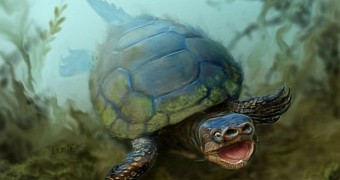Turtles are among Earth's oldest inhabitants. In fact, fossilized evidence unearthed in recent years indicates that the first such reptiles emerged around 250 million years ago. Countless species have since vanished, but turtles are still going strong.
In a study published in the Journal of Vertebrate Paleontology this Wednesday, scientists at the University of Utah describe a previously unknown turtle species that lived around 76 million years ago, during the Cretaceous Period, and that is one of the weirdest the world has ever seen.
Not the best-looking turtles in history
This previously undocumented turtle species was discovered and catalogued based on fossilized remains recovered from the Grand Staircase-Escalanta National Monument in southern Utah.
As mentioned, the reptiles lived around 76 million years. In those days, what is now the state of Utah was a wet and hot region, crisscrossed by rivers. There were also creeks, swamps and flood plains.
Paleontologist Joshua Lively and fellow researchers say these now-extinct turtles would grow to measure about 2 feet (0.6 meters) in length. They shared their habitat with tyrannosaurs and giant duck-billed dinosaurs.
What's interesting is that, as it turns out, the reptiles weren't exactly good looking, not by a long shot. Au contraire, the scientists describe them as having a pig-like nose complete with two bony nasal openings.
“All other turtles have just one external nasal opening in their skulls; the division between their nostrils is only fleshy,” the researchers explain in a report. “It's one of the weirdest turtles that ever lived,” adds Joshua Lively.
And so the turtles were named after bacon
This newly discovered ancient turtle species was named Arvinachelys goldeni by the University of Utah researchers, who picked this moniker to reflect its peculiar anatomy. Thus, the scientists say they named it after bacon.
“The pig-nosed turtle's scientific name, Arvinachelys goldeni, derives from arvina, a Latin word for pig fat or bacon, and chelys, Latin for tortoise,” they explain in a statement.
The team hope that, in time, a closer study of Arvinachelys goldeni and its anatomical quirks will help them better understand the evolutionary history of turtles on our planet.

 14 DAY TRIAL //
14 DAY TRIAL //